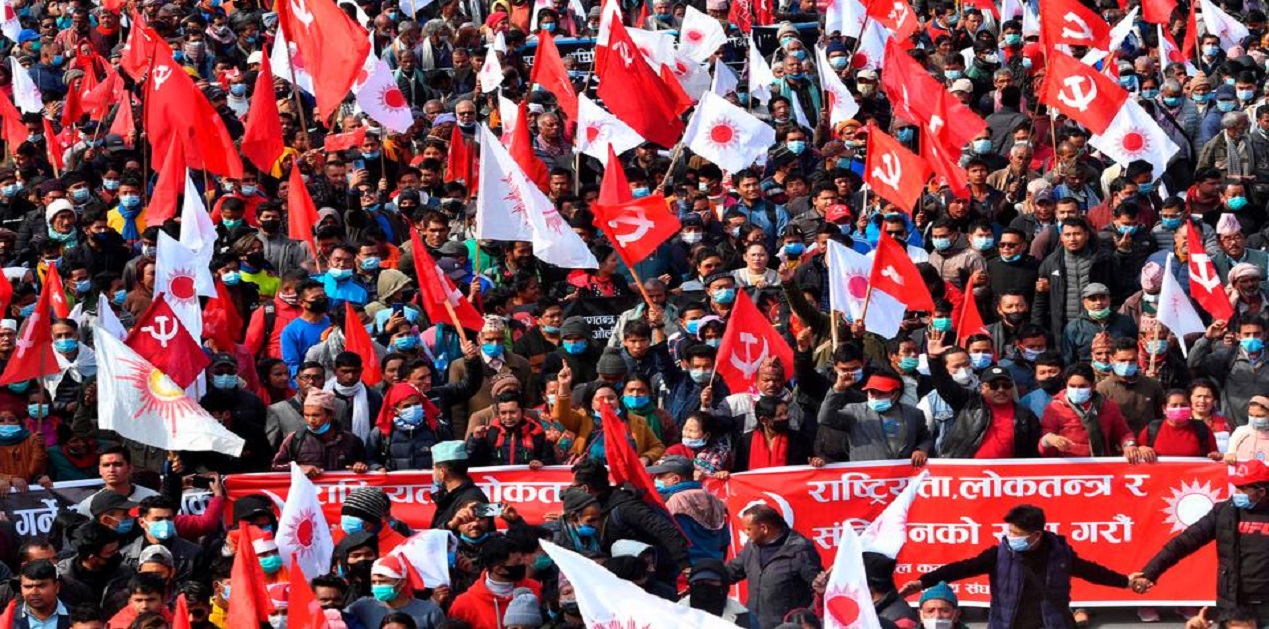Nepal has had a tumultuous past in terms of its politics and its road to democracy. After a prolonged period of instability, it finally became a multi-party federal republic with the implementation of the new Constitution in 2015. Over the course of the year 2022, Nepal has had significant developments worth noting in its economy and politics. These events are crucial to note, as they will determine the course of the country well beyond the year 2023.
Nepal’s year started off with a spike in COVID-19 cases. The government had imposed strict restrictions to mitigate the effects of the third wave. On 18 January, Nepal recorded the highest number of single-day infections, with 11,352 reported cases in 24 hours, owing to the highly infectious Omicron variant[1]. By mid-February, the cases had already decreased considerably, the schools were reopened, and the post-third wave normalcy emerged[2].
Economic
The COVID-19 pandemic and the ongoing Russo-Ukrainian war have led to supply chain disruptions and has hindered economic activity resulting in a global economic slowdown. Soaring inflation, rampant unemployment, hiked interest rates, and the looming fears of a recession are direct consequences of these international developments. According to World Bank’s ‘Global Economic Prospect Report,’ Nepal is expected to have an estimated growth rate of 5.8 per cent in the 2021-22 fiscal year[3].
The Nepali rupee is pegged to the Indian Rupee and depends heavily on imports for essential commodities. Subsequently, import costs and consumer goods prices rose due to the appreciating US dollar. The inflation in Nepal, at 74 months high, peaked at 8.64 per cent in September 2022. In December 2022, the Nepali rupee touched an all-time high of Rs 132.88 against the US dollar. Massive layoffs in the labour market during the lockdowns and increasing demand led to the spiking production costs as well as food prices.
In the first half of the year 2022, the foreign exchange reserves were under tremendous strain due to global inflation. The government in April 2022 imposed a restriction on imports of luxury and non-essential items to get the dwindling foreign exchange reserve situation under control. However, in July 2022, Nepal experienced an import explosion, with import bills going up to Rs. 1.92 trillion, a 24.7 per cent increase from the previous fiscal year. The exports also touched an all-time high at Rs. 200 billion. However, the trade deficit pushed Nepal closer towards an economic crisis.
In the second half of the year, the effects of the import ban on luxury products started showing effects. In the last five months of 2022, the imports decreased by 20.17 per cent. In January 2022 IMF approved a USD 395.9 million Extended Credit Facility (ECF) to help Nepal recover from the COVID-19 pandemic’s effects. It released USD 110 million immediately in the first instalment. However, it delayed the second instalment till Feb 2023 of USD 400 million claiming Nepal had failed to fulfil the policy requirements of a free market. In August, the government relaxed the ban on imports and finally lifted the ban in December after International Monetary Fund (IMF) expressed concerns regarding the economy’s health[4].
Politics
Millennium Challenge Corporation (MCC) Nepal Compact
The protests also took over Nepal in 2022. Nepal was already seeing a continuation of the lawyer’s protest from 2021 for the impeachment of Chief Justice CJ Rana when the demonstrations against the Millennium Challenge Corporation (MCC) Nepal Compact also began[5]. MCC is a US foreign aid agency which works independently of the US government. It uses 20 policy indicators to determine a country’s process to award a grant of a five-year term to them. Nepal signed an agreement of USD 500 million in 2017 for energy transmission and road development projects and to facilitate cross-border electricity trade between India and Nepal[6]. However, the bill had to be ratified in the recipient country’s parliament. Politics and opposition took over the media in February 2022, and multiple protests broke out in different parts of Nepal. The demonstrations on 20 February 2022 turned violent, and police had to use water cannons and tear gas to get the situation under control[7]. In a bid to exert pressure, the US issued a deadline to ratify the MCC bill by 28 February 2022. The Nepal Parliament then approved the MCC Nepal Compact on 27 February 2022[8].
Nepal Citizenship Bill
Fears of a constitutional crisis surfaced when President Bidiya Devi Bhandari declined to ratify the amendment to the Nepal Citizenship Bill for the second time in September[9]. Both houses of the Nepali Parliament first passed the bill in July. The President had returned the bill for review and reconsideration to the House of Representatives. Both houses again passed the bill by 2 September. Post submission, the President had a deadline of 15 days to ratify the bill. However, on 21 September, the President’s office stated that the President had refused to sign off on the bill[10].
The Citizenship Bill is to provide citizenship to more than 500,000 people. The issue of citizenship arises primarily due to the marriages between Indian and Nepalese people which lead to statelessness among such couples. There were massive protests that unfolded in reaction to the President’s decision. The Supreme Court of Nepal further issued a notice to the President’s office to explain the rationale behind the delay. In November, the President’s office responded by arguing that the decision to safeguard the Constitution was in line with her duty as a President[11]. The bill has been a contentious issue in the Nepali Parliament and has been heavily politicised by the political parties.
Federalism Debate
The question of the federalism governance model of Nepal also came under deep scrutiny before the November elections. Nepal has a three-tier federal governance structure, with a central government, seven provincial governments and 753 municipalities. The poor implementation of the federal governance model was widely discussed and criticised openly. The issue of federalism first came to light post the 2017 elections due to the volatile and unstable government in the centre[12]. On top of that, the elected representatives in the parliament could not fully comprehend the intricacies and operations of other administrative units in the federal system. The decision-making became more centralised than an effective federal government at every level of governance. The core issue arises from the fact that the Constitution of Nepal does not entirely and explicitly outlines the power, role and responsibilities at each level.
The problem became even more defined during the COVID-19 response of the government. District Administration Offices were directly answerable and accountable to the central government, as under the previous unitary system. However, the provincial and local governments had no power over it[13]. It highlighted not only the cracks in the federal structure but also the shortcomings of the Constitution and its understanding among politicians and civil servants, which directly affected the people adversely in the end.
Nepal Elections
Nepal also held its second elections at all levels of government since the enactment of the Nepalese Constitution in 2015. There were two pre-election alliances. The first was the democratic-left alliance, led by Nepali Congress. It constituted of the Communist Party of Nepal (Maoist Centre) (CPN-MC), Communist Party of Nepal (United Socialist), Loktantrik Samajwadi Party, and Rastriya Janamorcha. The second pre-election alliance was led by the Communist Party of Nepal (Unified Marxist–Leninist) (CPN-UML). It was joined by Rastriya Prajatantra Party and Janata Samajbadi Party. Out of 275 seats, Nepali Congress bagged the maximum number of seats in the general election with 89 seats, CPN-UML came in second with 78 seats, and CPN-MC secured 32 seats.
Despite the electoral alliances, after much political manoeuvring, the government was formed by a seven-party coalition consisting of CPN-UML, CPN-MC, Rashtriya Swatantra Party, Rastriya Prajatantra Party, Janata Samajbadi Party, Janamat Party, Nagarik Unmukti Party. Pushpa Kamal Dahal (Prachanda) of CPN-MC was sworn in as the new Prime Minister of Nepal on 26 December 2022.
Way Forward
- By the end of the year 2022, Nepal finally recorded zero COVID-19 cases, the first time in 31 months. The Covid cases are expected to stay in control unless a new wave sweeps over Nepal[14].
- World Bank’s report predicts Nepal’s economic growth for the fiscal year 2022-23 and 2023-24 to stand at 5.1 per cent and 4.9 per cent, respectively[15].
- According to Nepal’s central bank officials, inflation is expected to stay below the double-digit mark in the year 2023. Inflation is predicted to be a moderate 4 per cent in 2023. However, due to the high-interest rates of the central bank, inflation may still stay high[16].
- Nepal, as of now, is not entirely out of the woods in terms of its economy. The government’s spending is at Rs517 billion, but it only collected revenue of Rs 362 billion. An increase in revenue collection in 2023 is the only way to tackle economic slowdown and inflation[17].
- The MCC Nepal Compact is expected to come into force in August 2023. Nepal will have to stay vigilant to ensure a seamless implementation of the USD 500 million projects[18].
- Nepal is expected to see a louder call against federalism. The newly formed Rastriya Swatantra Party decided against contesting the provincial elections due to problems with the federal structure. Whereas parties like Rastriya Prajatantra Party and Rastra Janamorcha Party have called to do away with the federal structure completely, owing to the dysfunctionality within the provincial government[19].
- Nepal will be electing its third President in its fourth presidential election in March 2023. The selection of a President will undoubtedly bring about a lot of political manoeuvring among the ruling alliance parties for the power grab.
- The issue of the Citizenship bill will arise again with the new government. The new President’s election will certainly determine the course of this decision.
- The relationship between the parties and the voters is changing rapidly, and the parties will have to keep up with the youth of Nepal to stay relevant in the Nepali political landscape. The need for political parties to reinvent themselves has become pertinent now.
- Experts are predicting the fall of the current coalition before the five-year term based on previous experience and the power-sharing arrangement within the cabinet.
In recent developments, the Presidential election has already cracked the ruling alliance. The party with the second highest votes in the general elections, CPN-UML, pulled away its support from the Prachanda-led government on 1 March 2023. The rift was caused by Prachanda supporting the Nepali Congress candidate in the upcoming Presidential election. The Rashtriya Prajatantra Party (RPP) has also withdrawn its support to the government. On the other hand, the Rashtriya Swatantra Party (RSP), the party with the fourth highest votes, has also quit the government, though it still supported the government in the parliament. Hence the ruling coalition has now disintegrated. The Nepali Congress and Maoist Centre have joined hands once again and are set to form the government.
Nepal experienced substantial developments in the year 2022. These events together created an atmosphere of uncertainty and curiosity throughout the year. Due to the tumbling economy, the controversies and the elections, Nepal was closely watched and followed. Nepal has always been unpredictable in its politics, and the year 2023 will be no different. It will be interesting to follow the unpredictability curve in Nepal’s economy and politics.
Endnotes :
[1]https://www.aninews.in/news/world/asia/with-11352-covid-19-cases-nepal-records-highest-single-day-spike-since-pandemic-began20220119201509/
[2]https://www.thehindu.com/news/international/covid-19-nepal-to-reopen-schools-other-venues-as-coronavirus-cases-fall/article38391282.ece
[3]https://www.worldbank.org/en/publication/global-economic-prospects
[4]https://www.imf.org/en/News/Articles/2022/01/13/pr2206-nepal-imf-executive-board-approves-us-million-ecf-arrangement
[5]https://myrepublica.nagariknetwork.com/news/agitated-lawyers-continue-protest-outside-supreme-court/
[6]https://www.wionews.com/south-asia/mcc-ratification-nepals-sovereign-decision-us-454675
[7] https://www.wionews.com/south-asia/nepal-presidents-unconstitutional-move-on-citizenship-bill-sparks-protest-518475
[8] https://thediplomat.com/2022/03/nepal-ratified-the-mcc-compact-what-now/
[9]https://www.hrw.org/news/2022/09/26/nepal-president-blocks-citizenship-law
[10]https://www.loc.gov/item/global-legal-monitor/2022-10-23/nepal-president-declines-to-authenticate-new-amendment-to-citizenship-act-for-second-time/
[11] https://kathmandupost.com/national/2022/11/17/president-defends-move-on-citizenship
[12] https://www.jurist.org/features/2023/01/11/explainer-nepals-rocky-road-to-federalism/
[13] https://english.onlinekhabar.com/federal-system-in-nepal-challenges.html
[14]https://kathmandupost.com/health/2022/12/18/nepal-records-no-covid-19-cases-for-the-first-time-in-31-months
[15]https://english.onlinekhabar.com/world-bank-nepal-economy-2023-jan.html
[16]https://kathmandupost.com/special-supplement/2022/12/29/nepal-s-economy-busted-by-covid-war-and-inflation
[17]https://myrepublica.nagariknetwork.com/news/revenue-collection-must-rise-to-protect-economy-from-slowdown-and-inflation/
[18]https://www.daijiworld.com/news/newsDisplay?newsID=1044946
[19]https://english.onlinekhabar.com/2022-review-nepali-politics.html










Post new comment